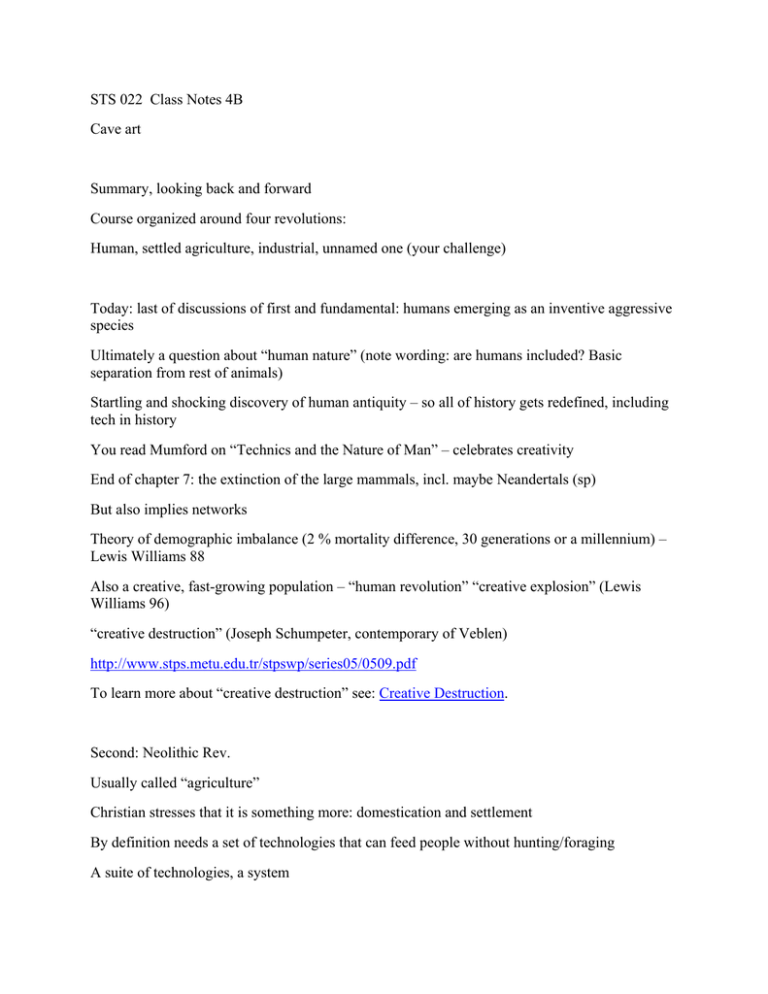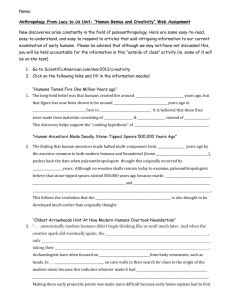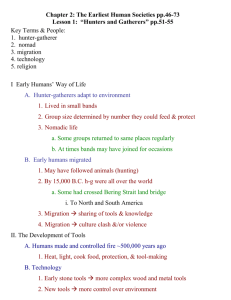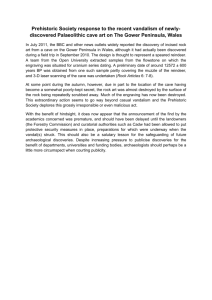Document 13654831
advertisement

STS 022 Class Notes 4B Cave art Summary, looking back and forward Course organized around four revolutions: Human, settled agriculture, industrial, unnamed one (your challenge) Today: last of discussions of first and fundamental: humans emerging as an inventive aggressive species Ultimately a question about “human nature” (note wording: are humans included? Basic separation from rest of animals) Startling and shocking discovery of human antiquity – so all of history gets redefined, including tech in history You read Mumford on “Technics and the Nature of Man” – celebrates creativity End of chapter 7: the extinction of the large mammals, incl. maybe Neandertals (sp) But also implies networks Theory of demographic imbalance (2 % mortality difference, 30 generations or a millennium) – Lewis Williams 88 Also a creative, fast-growing population – “human revolution” “creative explosion” (Lewis Williams 96) “creative destruction” (Joseph Schumpeter, contemporary of Veblen) http://www.stps.metu.edu.tr/stpswp/series05/0509.pdf To learn more about “creative destruction” see: Creative Destruction. Second: Neolithic Rev. Usually called “agriculture” Christian stresses that it is something more: domestication and settlement By definition needs a set of technologies that can feed people without hunting/foraging A suite of technologies, a system Christian also stresses that in hybrid form it lasted a long time: settled agr.with nomads, foragers Think: Roman Empire and Goths Think: America and Australian indigenous peoples; Afghanistan Christian also stresses that this change is not necessarily progress Raises deep question of free will: why don’t humans make inventions, new technologies that make them happier and better off? (unanticipated consequences, foreclosing options) Third: emergence of a civilization based on industrial production fueled by fossil fuels Latter doesn’t get enough attention: displacement of organic sources (wind, water, muscles of animals and people) Vast increase in productivity; vast increase in disparities Marx: “prehistory” is over, it’s a new human condition The unnamed revolution beginning around turn of 20th century “information” is part but not the whole Mumford at beginning of “technics and human nature” – an artificial world – no more beyond the human Remember Christian’s emphasis on geographical consolidation, networks, from many to one Keep asking yourself this question as we proceed: what is it? Keep two things in mind: Problem with term “revolution” no matter what the modifier Borrowed from science, then to politics, then to “industry” (Toynbee) Image from storming of Bastille, or maybe Russian Rev of 1917: you have a government, you overthrow it, kill the powerful and install new leaders Christian’s comments on human revolution – it didn’t erupt in Europe in 40000 to 50000 BP Longer development in Africa (McBrearty and Brooks article; also cited by L-W 96) Neolithic Rev It took a long time; they were not aware of what they were doing (consciousness); many subinventions go into the big one of “agriculture”; and things accumulate (foraging lasts a long long time; agriculture lasts into present; means continue to be used, are not displaced) But inarguably a change in human condition Second thing to keep in mind: what changes is not just material means but understanding of ends around which the means are organized - teleology Means accumulate but meanings succeed each other – Gauguin: where are we coming from, where are we going, what does it mean? (In Boston Museum of Fine Arts) – ultimately unanswerable questions, or rather answers change To learn more about Paul Gauguin’s Where Do We Come From? What Are We? Where Are We Going? See: Gauguin: Where Do We Come From? What Are We? Where Are We Going? These questions do not appear in hierarchical order (Maslow) – physical then spiritual needs In fact they define the human revolution: symbolic mastery Another energy source: psychic energy, what you care about, are willing to live and die for Lots of survival technologies: weaving, pottery, dwellings, hunting tools First sign of human is not fire, axes, but jewelry, art meaning in kinship, tribe, fertility, a spirit world Early civilizations: role of organized state, ruler and priests – later combines with monotheism we will read about Christian belief in Virgin Mary as a source of energy (Henry Adams) Industry – “progress” defined either as democracy or as production, wealth Now: sustainability, back to living with nature - ? Talk about Clan of Cave Bear in this light – their tools, their ends Symbol, art, abstraction Language: here and now, life, death, strength, birth, sex, food Physical weakness of the shaman Pidgin-Aurignacian – communication - simple “We need to distinguish between those kinds of art that can interact to produce viable new forms and those that cannot evolve into other types” (Lewis Williams 89) Generative grammar analogy Could body decoration (red ochre, jewelry) evolve into two D images on a cave wall? They signify clan membership and also stages of kinship (puberty, marriage, childbearing) Animals that hunt other animals are singled out for display Hunting associated with supernatural realm Neanderthals did not take over pictures or carvings – body-painting does not evolve into imagemaking – could not remember altered states of consciousness or manipulate that imagery; could not imagine an alternative reality (spirit world); could not recognize connection between 2D and 3D Nor burial with elaborate grave goods, nor advanced hunting strategies Larger social networks Face to face exchanges of artefacts and information – beyond face to face Burial with lots of grave goods indicates social networks Lewis Williams’ argument that the Aurignacians actively cultivated the characteristics of their lives that distinguished them (set them “above”) the Neandertals – Neandertals coping with new arrivals around 45000 to 35000 BP – cave art as a form of social distinction Cave art: what they care about – quest for meaning Cave painting as needing many technologies (Mithen mentions some) Caves were handy – earth art is universal but not cave art – sealed in time by ice ages - also portable art The dancing sorcerer image, from Trois Freres cave, Ariege In a very hard to reach part of the cave – part human, part animal Font de Gaume 15-17000 BP – warmer then The most extended frescoes are at the back, difficult to see Sophistication of the images Perspective: twisted, to show movement “3-D” Cinematic effects Curves of stone make belly of horses One leg serves for both bison and deer Mastery off observation of habits, shapes Two colors/ polychromatic, only one still open Iron oxide is red, manganese dioxide powder is black Four types of images: animals, stick people, geometry (tectiforms), hand Ways of making images: hand/fingers, brush, blowpipe 100% humidity, necessary to keep paint on walls, mixed with water Les Combarelles Very narrow 600 engravings mainly horses 52 of the anthropomorphic 15000 BP Discovered 1901 authenticated by Abbe Breuil Flint used to engrave Calcite over engraving Lascaux – “Sistine chapel of prehistory” – shaped like a sanctuary Discovered 1940, closed since 1963 Lascaux II “light show” of guide ¾ view, overlaps of herd Forelegs of cow are stone Stylized animals: horses have small head, deers have big antlers The shaman? Sorcerer? Cougnac Pillar in middle Music, on stalagmites and tites – flute found Inner sanctum Broken stalagmites/tites en route Great drawing showing how stone shapes are used for legs of ibex Wounded human figures on animals Many “blazes” on animals Drawn 25000-27000 Finger marks 14000 Pech-Merle Very hard to get to, sealed up 12000 with return of cold weather 16000 BP black frieze’ Black frieze: horse, bison, mammoth Also mammoth and auroch (black frieze) One artist, knew order, sketched first Elongated head of bear so you see it as if from an angle Horse done 24000 BP – hands – red dots, ochre, spitted dots Also aviform and tectiorms and One line does a mammoth Sketched with finger first Claw marks of cave bear - teeth Footprint of children, teenage boy Chauvet disc. 1994 by 3 spelunkers, one named Chauvet – in Rhone valley Now active searching: e.g. three friends (two men, one named Chauvet, one woman) feel a draught, remove some rubble (modern entrances often not the prehistoric ones), goes down 10 m tunnel, find chamber, get a ladder See mammoth, rhino, dots, handprints, horses heads, skull of a dave bear with its canine teeth hooked over an edge, even deeper find lion heads “we were seized by a strange feeling. Everything was so beautiful, so fresh, almost too much so. Time was abolished, as if the tends of thousands of years that separated us from the producers of these paintings no longer existed. It seemed as if they had just created these masterpieces. Suddenly we felt like intruders….we were weighed down by the feeling that we were not along; the artists’ souls and spirits surrounded us. We thought we could feel their presence; we were disturbing them.” (imagine similar feelings in Chauvet 27000) – in book pub. 1996 quoted in Lewis Williams 17 32000-30000 yrs ago – 22 dates Earliest known cave paintings 2nd occupation 27000-26000 yrs BP (torch wipes, no paintings tho) – 7 dates Maybe a third around 22,800 Foot and animal prints – foot from earliest known anatomically modern human Esp. bears Hearths set up to produce wood charcoal for coloring (also illumination) Step dug - flints Levi-Strauss spoke of myth growing “spiral-wise” until the “intellectual impulse which has produced it is exhausted.” (in Structural Anthropology 1963) UP nexus of mental states, fixed imagery, social relations and caves lasted until 10000 BP, long after the demise of the Neandertals – thereafter locus of spirit world was built above ground Clan of the Cave Bear assignment: ask how literature helps imagine a whole way of life, with everything integrated What are other ways to accomplish this? biographies MIT OpenCourseWare http://ocw.mit.edu STS.007 Technology in History Fall 2010 For information about citing these materials or our Terms of Use, visit: http://ocw.mit.edu/terms.






